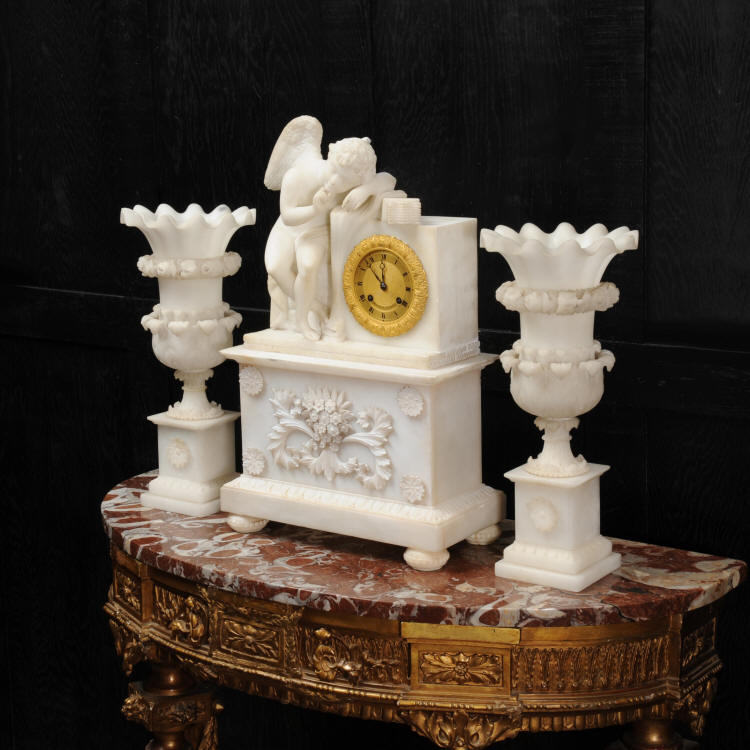The dial is mercury gilded bronze (Bronze Doré) with engine turned centre and Breguet hands in blued steel. The dial is signed for the clockmaker Philippe Thomas of Paris. The French movement is of high quality and is in excellent clean and running condition. It is an early movement with silk suspension and outside hammer spring. Pendulum is a replacement. It runs for 8 days and strikes the hours and halves on a bell. Click the video clip below to hear the bell and watch the clock running! This famous Sèvres model is known as l'Amour Falconet after designer Etienne Maurice Falconet, director of sculpture at Sèvres from 1757 to 1766. He exhibited the original plaster versions of the figure at the Salon in 1755. The marble version of Cupid, made for Madame de Pompadour, was exhibited at the Salon in 1757, and then went to the Hôtel d’Evreux, her Paris house, which is now the Elysée Palace. The following year, 1758, the model was produced in biscuit at Sèvres. His pair, Psyche, was first produced in biscuit in 1761. Cupid was always known as L’Amour Falconet at Sèvres. The plaster and marble versions have been variously called L’Amour Menaçant, L’Amour Silencieux and Garde à Vous. The first biscuit example was sold on December 28, 1758 and Madame de Pompadour purchased one on December 30. Other royal purchasers of biscuit Cupids include the duc d’Orléans, Madame Victoire, Marie-Antoinette, Louis XVI and the duchesse de Chartres. Cupid is called “threatening” (menaçant) because he is about to withdraw a treacherous arrow – which compels its victim to fall in love – from his quiver, while placing a finger to his lips to signify silence or a secret. There are several clockmakers named Thomas listed in Tardy; Dictionnaire Des Horlogers Francais, but Philippe Thomas fits the date of this clock. He is listed as working in Rue J.J. Rousseau in 1820. Ref: Department of Sculptures, Room 222 The Louvre. Rijksmuseum, Amsterdam, room 1.9. British Museum; A Catalogue of French Porcelain in The British Museum, London, BMP, 1994, Dawson 1994. Savage, George, Seventeenth and Eighteenth Century French Porcelain, London, Barrie & Rockliff, 1960. Condition of the case is good, alabaster is a fragile material and there are several small losses and repairs. Cupids wing has a repair, there is a repaired chip to the right hand side of the base and there is a glued repair to the stem of one vase. Losses include 2 fingers to cupids hand, an acanthus leaf on the rear of one urn and small losses to the applied rosettes on the clock and vase bases. There is some discolouration and staining of the alabaster. The vases have previously been wired as lamps. Dial is in lovely bright condition.
Complete with pendulum, bell and a suitable key. Full setting up instructions supplied if required.
About us - All of our clocks are original antiques, we source most of our clocks in France, Belgium, the Netherlands and the UK. We prefer to buy our clocks in original 'dirty' condition. We then clean the cases using a technique we have developed over many years. We employ two qualified clockmakers who overhaul the movements. Movements are thoroughly tested until we are satisfied that they will run trouble free. |
||||||||||||||||||||||
|
Click the movie player below to see the this actual clock
run -
|
























Customer satisfaction is always guaranteed at Dragon Antiques!




